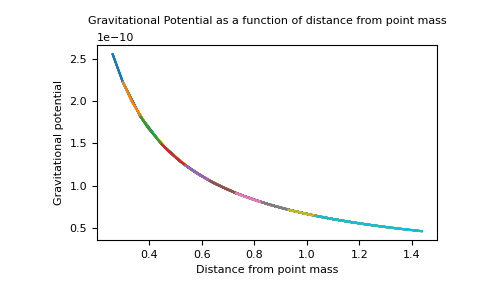geoana.gravity.PointMass.gravitational_potential#
- PointMass.gravitational_potential(xyz)#
Gravitational potential due to a point mass. See Blakely, 1996 equation 3.4.
\[U(P) = \gamma \frac{m}{r}\]- Parameters:
- xyz(…, 3) numpy.ndarray
Observation locations in units m.
- Returns:
- (…, ) numpy.ndarray
Gravitational potential at observation locations xyz in units \(\frac{m^2}{s^2}\).
Examples
Here, we define a point mass with mass=1kg and plot the gravitational potential as a function of distance.
>>> import numpy as np >>> import matplotlib.pyplot as plt >>> from geoana.gravity import PointMass
Define the point mass.
>>> location = np.r_[0., 0., 0.] >>> mass = 1.0 >>> simulation = PointMass( >>> mass=mass, location=location >>> )
Now we create a set of gridded locations, take the distances and compute the gravitational potential.
>>> X, Y = np.meshgrid(np.linspace(-1, 1, 20), np.linspace(-1, 1, 20)) >>> Z = np.zeros_like(X) + 0.25 >>> xyz = np.stack((X, Y, Z), axis=-1) >>> r = np.linalg.norm(xyz, axis=-1) >>> u = simulation.gravitational_potential(xyz)
Finally, we plot the gravitational potential as a function of distance.
>>> plt.plot(r, u) >>> plt.xlabel('Distance from point mass') >>> plt.ylabel('Gravitational potential') >>> plt.title('Gravitational Potential as a function of distance from point mass') >>> plt.show()
(
Source code,png,pdf)